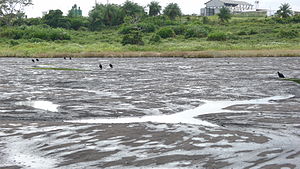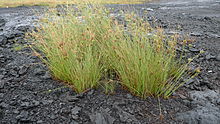Trinidad natural asphalt

Trinidad natural asphalt is the name of a naturally occurring raw material made from natural bitumen and aggregates on the island of Trinidad . It is added in small quantities to the construction asphalt , the binder of which consists of bitumen artificially obtained from petroleum , in order to improve its properties. Adding up to 3.0% by mass of Trinidad natural asphalt can be particularly useful for traffic areas with high levels of traffic from heavy traffic .
The natural asphalt is made up of one third each of water, bitumen and minerals and improves the properties of the road construction bitumen in terms of:
- Wetting,
- Adhesive strength,
- Deformation resistance and
- Aging resistance
Occurrence and extraction
The Trinidad natural asphalt comes from La Brea Pitch Lake on the Caribbean island of Trinidad. Its diameter is 450 meters and its surface is 25 meters above the nearby sea. It was discovered by Sir Walter Raleigh in 1595 . The natural bitumen source at the bottom of the lake is the most productive of its kind in the world.
Up until a few decades ago, the natural asphalt, which had a high water content in its raw state, was extracted by hand by chopping out larger chunks of asphalt from the surface. Since the 1960s, the extraction has been largely automated. The asphalt is scraped off with bulldozers and pushed together into rents. The fragments are transported to the lakeshore by means of wheel loaders, tractors and trucks, and from there they are transported to large melting tanks on rail-guided trucks. The raw asphalt is liquefied by heating to 140 ° C to 150 ° C. The free water content of approx. 30% evaporates in the process. The melting tanks are equipped with slow-running agitators, which prevent the fine minerals from settling. Through several sieves in the filling lines, coarser ingredients that are sometimes contained or introduced by the degradation process are filtered out. After complete cleaning (epuré ~ French: cleaned, refined), the viscous Trinidad natural asphalt is drawn off in hard fiber barrels made on site, in which it cools and solidifies. After several days, so much natural asphalt was pushed back to the surface by the geological activity under the lake that material can be extracted again at the same place.
composition
In the form in which the Trinidad natural asphalt is extracted from Pitch Lake , it is a relatively uniform mixture of water, mineral components and bitumen with the following average composition:
| bitumen | 39.3 mass% |
| Mineral components | 27.2 mass% |
| Water etc. volatile up to 160 ° C | 29.0-30.2 mass% |
| Water of hydration | 3.3 mass% |
This mixture is more or less to be regarded as an emulsion. The natural Trinidad asphalt in its original condition is not suitable for practical use. It is therefore subjected to a melting process. The cleaned and bottled Trinidad natural asphalt always has the following composition:
| Soluble bitumen | 53.0-55.0 mass% |
| Minerals | 36.0-37.0 mass% |
| remaining components | 9.0-10.0 mass% |
The "remaining components" are components of Trinidad Epuré that cannot be assigned to either bitumen or minerals. They can be determined by ashing. The minerals are composed of:
| <0.063 mm | 90.2 mass% |
| 0.063-0.125 mm | 9.8 mass% |
Since Trinidad Epuré is only added to the asphalt in amounts up to a maximum of 3.0 mass%, max. Contains 0.3 mass% of "remaining components" or 0.4 mass% of the grain class> 0.063 mm. Because of these small quantities, it is permissible and technically justifiable to regard the “remaining components” as fillers (0–0.063 mm). In addition, Trinidad Epuré still contains crystalline bound water. This cannot be removed from the Trinidad Epuré during binder extraction. It is only partially released at temperatures> 150 ° C and in part causes the well-known good workability of Trinidad natural asphalt. This water content is not taken into account in the mathematical treatment of Trinidad natural asphalt products. Other features:
| colour | Matt black |
| density | 1.40-1.42 g / cm³ |
| penetration | 1-4 0.1 mm |
| EP RuK | 93-98 ° C |
| Sulfur content | 6–8 mass% |
The bitumen that can be removed from the Trinidad Epuré by extraction according to TP A-01 has the following properties:
| density | 1.06-1.08 g / cm³ |
| penetration | 3-12 0.1 mm |
| RuK softening point | 68-78 ° C |
Analysis data
Other characteristic values of Trinidad Epuré:
| colour | black |
| fracture | shell-like |
| shine | dull |
| Line | black |
| Mass density at 25 ° C | 1.4-1.42 g / cm³ |
| Penetration at 25 ° C | 1.5-4.0 0.1 mm |
| Ductility at 25 ° C | 1.0-1.8 cm |
| Softening point Kraemer-Sarnow | 84-87 ° C |
| Softening point ring and ball | 94-97 ° C |
| Loss of evaporation at 160 ° C in 5 hours | 1.1-1.7% |
| Sulfur content | 6.0-8.0 mass% |
| Volume expansion coefficient | 0.000517 K −1 |
| spec. warmth | 0.437 |
| Electric breakdown strength | 58 kilovolts |
A closer look at the table above shows that the sum of the bitumen soluble in carbon disulfide and the mineral content does not add up to 100% by mass. The difference is explained by the presence of undissolved organic matter (partly bitumen), which is lost during combustion. In Trinidad natural asphalt, the fine mineral components are able to hold bitumen in place through absorption. The amount of this insoluble bitumen was found to be about 1.3 mass%. In relation to Trinidad Epuré it is about 0.5 mass%. The remaining part of the material, which cannot be identified in detail, consists of hydration water, volatile parts of the clay and the other minerals in the mineral part and organic substances, mainly of vegetable origin. It is not possible to give precise details about these components. The total proportion of this unspecified material rarely exceeds 9 to 10 mass%.
The mineral components present in Trinidad Epuré are between 36 and 38 mass% of the total weight. They essentially consist of quartz and clay and the residue of salts that have been emulsified in the raw Trinidad natural asphalt in the course of its history.
literature
- Laboratory manual for Trinidad natural asphalt. Published by Carl Ungewitter Trinidad Lake Asphalt GmbH & Co. KG, Bremen 2013 ( PDF 2.0 MB)
